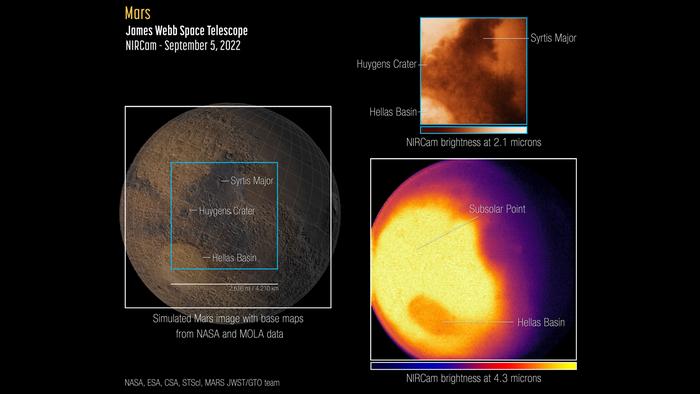Inside the cosmos: James Webb Space Telescope continues to dazzle
Images from the James Webb Telescope reveal never-before-seen details and
beauty of the universe.

Webb's first images of Mars
The James Webb Space Telescope has taken its first images of Mars. They show part of its eastern, sunlit hemisphere. The close-up image on the left shows surface features such as Huygens Crater, the dark volcanic Syrtis Major and the Hellas Basin. The "heat map" on the right shows how Mars emits light when it loses heat.
12345678

NASA shared the first images of Mars captured by the James Webb Space Telescope Monday. Photo by NASA, ESA, CSA, STScI, Mars JWST/GTO team.
Sept. 19 (UPI) -- NASA announced Monday that the James Webb Space Telescope captured the blinding infrared light from Mars earlier this month.
The images show the eastern hemisphere of Mars in different wavelengths of infrared light. NASA said that the new images will help advance scientific study of the red planet.
"Webb can capture images and spectra with the spectral resolution needed to study short-term phenomena like dust storms, weather patterns, seasonal changes, and, in a single observation, processes that occur at different times (daytime, sunset, and nighttime) of a Martian day," the agency said in a blog post.
In fact, the telescope was so sensitive that astronomers had to make adjustments to prevent the blinding light from saturating the telescope's detectors.
Some of the images show the rings of the Huygens Crater, the dark volcanic rock of Syrtis Major and brightening in the Hellas Basin.
"The Hellas Basin is a lower altitude, and thus experiences higher air pressure. That higher pressure leads to a suppression of the thermal emission at this particular wavelength range [4.1-4.4 microns] due to an effect called pressure broadening," Geronimo Villanueva, the principal investigator of NASA's Goddard Space Flight Center, said. "It will be very interesting to tease apart these competing effects in these data."
The researchers are preparing a paper they will submit to a scientific journal for peer review and publication.
No comments:
Post a Comment